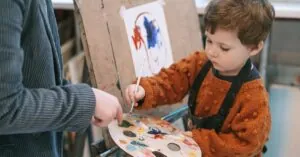Table of Contents
TogglePreschool craft time isn’t just about glue sticks and glitter; it’s where little hands become mighty creators. Imagine a world where every crayon stroke and paper cut transforms into a masterpiece. These activities not only spark creativity but also help develop essential skills like fine motor control and problem-solving.
Overview Of Preschool Craft
Craft activities in preschool provide essential opportunities for children to engage in creative expression. Children develop fine motor skills when they manipulate various materials, such as paper, glue, and scissors. Problem-solving capabilities emerge as they figure out how to assemble their creations, leading to increased confidence in their abilities.
The variety of craft projects helps stimulate children’s imaginations. Examples include paper plate animals or painted rocks that encourage creativity and innovation. Engaging in crafts also promotes social skills, as children often work in groups, sharing ideas and techniques.
Furthermore, craft time aligns with educational goals. Incorporating themes like seasons or holidays can enhance learning experiences while reinforcing concepts taught in the classroom.
Educators often observe that hands-on activities like these hold children’s attention better than traditional methods. Each project, whether it’s making a collage or creating a clay sculpture, builds a sense of achievement, encouraging exploration and experimentation.
Preschool crafts not only foster artistic skills but also nurture emotional development. Art provides a safe outlet for children to express their feelings, helping them to communicate effectively.
Instructors facilitate this process by selecting age-appropriate materials and guiding children through techniques. The interaction between educators and students further enriches the craft experience. Thus, preschool craft activities serve both educational and developmental purposes, making them vital in early childhood education.
Benefits Of Preschool Craft
Engaging in preschool crafts offers numerous developmental benefits. Children not only express creativity but also learn vital skills through hands-on activities.
Enhancing Creativity
Craft projects allow kids to explore their imaginations. From painting and drawing to sculpting, these activities encourage original ideas. Children can combine various materials, promoting inventive thinking. They learn to visualize concepts and bring them to life through art. The process of creating something unique fosters self-confidence in their abilities. Crafting also invites experimentation, offering opportunities to try new techniques and styles. As kids share their creations, they gain feedback, further enhancing their creative expression.
Developing Fine Motor Skills
Craft activities significantly improve fine motor skills. Children manipulate scissors, paintbrushes, and glue, enhancing hand-eye coordination. They engage in intricate tasks like drawing lines or folding paper, developing dexterity. Mastering these skills lays the groundwork for future writing and task completion. Through repetitive motions involved in crafting, kids gain better control of their movements. Grasping small objects and using tools develops strength in their fingers and hands. As they become more proficient with these tasks, children grow more independent in their everyday activities.
Popular Preschool Craft Ideas
Crafts can offer endless possibilities for preschoolers, engaging their creativity and learning through enjoyable projects. Here are some popular ideas that cater to different themes.
Seasonal Crafts
Seasonal crafts connect with children’s experiences throughout the year. Fall-themed crafts, such as creating leaf collages or pumpkin decorations, introduce colors and textures. Winter projects can include making snowflakes or decorating pinecones to represent the holidays. Spring invites kids to create flower pots or handprint butterflies, adding vibrant colors and patterns. Summer projects often involve crafting beach-themed items, such as seashell art or paper plate sun hats. Engaging with these seasonal activities encourages children to observe and discuss changes in nature while reinforcing their understanding of seasonal concepts.
Educational Crafts
Educational crafts promote learning through hands-on experiences. Counting and sorting activities can center around making colorful bead necklaces. Shape recognition might involve creating geometric shapes using construction paper. Letter crafts, such as decorating cardboard letters with various textures, enhance literacy skills. Science-themed projects, including creating simple volcanoes with baking soda and vinegar, introduce basic scientific concepts. Each of these crafts incorporates educational elements while allowing children to explore and express their creativity. Educators can align projects with curriculum goals, ensuring that learning occurs in a fun, engaging manner.
Tips For Effective Preschool Craft Activities
Selecting age-appropriate materials enhances children’s engagement during craft activities. Opt for safer items, such as non-toxic glue, child-safe scissors, and washable paints. These ensure a secure and enjoyable experience while reducing any hazards.
Incorporating themes into craft projects fosters connections to educational goals. Use seasonal concepts like snowflakes for winter or flowers for spring to enhance relevance. This approach links creative expression with learning objectives, enriching the overall experience.
Setting clear expectations helps maintain focus and organization. Explain the project steps before starting to prepare children for what to expect. This structured guidance supports effective participation and nurtures independence throughout the process.
Encouraging open-ended exploration allows children to express their creativity freely. Design projects that invite imagination, such as creating their animal projects or unique sculptures. Such flexibility lets kids explore their ideas while developing problem-solving skills.
Providing collaborative opportunities fosters social interaction among peers. Group craft activities enable children to work together, sharing materials and ideas. This promotes teamwork and strengthens relationships while enriching creative expression.
Offering diverse projects introduces various techniques and skills. Include activities like collage-making, painting, or even simple sewing. Exposure to different methods enhances fine motor skills and broadens children’s artistic experiences.
Celebrating completed crafts boosts children’s confidence and sense of accomplishment. Display finished works in the classroom or at home, giving children recognition. This acknowledgment reinforces the value of their efforts and encourages continued engagement in creative activities.
Safety Considerations For Preschool Craft
Safety is paramount during preschool craft activities. Selecting non-toxic materials protects children’s health while fostering creativity. Checking for age-appropriate tools ensures children can use them without risk. For instance, using child-safe scissors prevents accidents while helping kids develop fine motor skills.
Supervision plays a vital role in ensuring safety. An adult’s presence helps monitor activities and guide children on proper usage of materials. Implementing rules about handling tools encourages awareness and responsibility. Parents and educators should communicate these guidelines clearly to ensure a safe environment.
Creating a designated crafting space enhances safety. Establishing boundaries keeps children focused and minimizes distractions. Keeping hazardous items, such as sharp objects or small choking hazards, out of reach further promotes safety. Additionally, using washable materials simplifies cleanup, limiting exposure to messes.
Emergency preparedness is essential for all craft sessions. Having a first-aid kit nearby allows for prompt responses to minor injuries. Educators should familiarize themselves with basic first-aid techniques in case an incident occurs. Sharing safety plans with parents reinforces a collective responsibility for children’s well-being.
Cleaning up after crafts contributes to a safe space. Encouraging children to assist with cleanup teaches responsibility while maintaining order. Regularly inspecting crafting areas ensures no unsafe materials remain accessible. These actions create a habit of vigilance and safety awareness among children.
Incorporating these safety considerations provides a secure environment for preschool crafts. Prioritizing safety ensures children can explore creativity without unnecessary risks.
Preschool crafts play a crucial role in early childhood development. They offer children a unique platform to explore their creativity while honing essential skills. Through hands-on activities, kids enhance their fine motor abilities and problem-solving skills in a fun and engaging way.
Craft time also fosters social interactions and teamwork, allowing children to collaborate and share ideas. By integrating educational themes into these projects, educators can enrich learning experiences that align with curriculum goals. Prioritizing safety and age-appropriate materials ensures a secure environment where children can express themselves freely.
Ultimately, preschool crafts not only nurture artistic expression but also lay the foundation for future learning and personal growth. Embracing these creative opportunities can significantly impact a child’s development and confidence.




